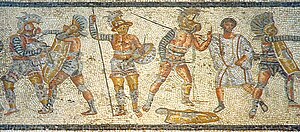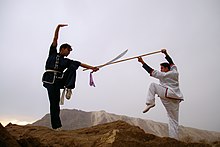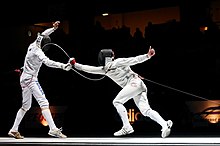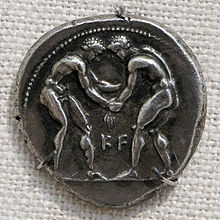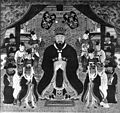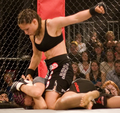Portal:Martial arts
The Martial Arts Portal

Martial arts are codified systems and traditions of combat practiced for a number of reasons such as self-defence; military and law enforcement applications; competition; physical, mental, and spiritual development; entertainment; and the preservation of a nation's intangible cultural heritage. (Full article...)
Although the earliest evidence of martial arts goes back millennia, the true roots are difficult to reconstruct. Inherent patterns of human aggression which inspire practice of mock combat (in particular wrestling) and optimization of serious close combat as cultural universals are doubtlessly inherited from the pre-human stage and were made into an "art" from the earliest emergence of that concept. Indeed, many universals of martial art are fixed by the specifics of human physiology and not dependent on a specific tradition or era.
Specific martial traditions become identifiable in Classical Antiquity, with disciplines such as shuai jiao, Greek wrestling or those described in the Indian epics or the Spring and Autumn Annals of China. (Full article...)
Selected articles
Selected biography
Selected entertainment
Girlfight is a 2000 American sports drama film written and directed by Karyn Kusama in her feature directorial debut, and stars Michelle Rodriguez in her first film role. The film follows Diana Guzman, a troubled Brooklyn high school student who decides to channel her aggression by training to become a boxer, despite the disapproval of both her father and her prospective trainers, as well as the competitors in the male-dominated sport.
Kusama wrote the screenplay for Girlfight after learning to box, wanting to make a film about the sport with a female protagonist. Although she struggled to find financiers for the film's $1 million budget, the production was eventually funded by John Sayles, Maggie Renzi and the Independent Film Channel. Rodriguez was cast in the lead role despite having never acted before, and trained in boxing for four months before filming commenced in New York and New Jersey.
Girlfight premiered at the Sundance Film Festival on January 22, 2000, where it tied with You Can Count on Me for the Grand Jury Prize, and Kusama won the Best Director Award. It was theatrically released on September 29, 2000, to critical acclaim, with particular praise for Rodriguez's performance and Kusama's direction. The film earned several accolades, including a nomination for the Bronze Horse at the 2000 Stockholm International Film Festival. At the 16th Independent Spirit Awards, Kusama was nominated for Best First Feature and Rodriguez won for Best Debut Performance.
Sports portals
Selected image
 |
The épée (English: /ˈɛpeɪ/ or /ˈeɪpeɪ/, French pronunciation: [epe]), sometimes spelled epee in English, is the largest and heaviest of the three weapons used in the sport of fencing. The modern épée derives from the 19th-century épée de combat, a weapon which itself derives from the French small sword.
As a thrusting weapon, the épée is similar to a foil (contrasted with a sabre, which is designed for slashing). It has a stiffer blade than a foil. It is triangular in cross-section with a V-shaped groove called a fuller. The épée also has a larger bell guard designed to protect the user’s arm. In addition to the larger “bell” guard and blade, the épée weighs more than the foil and sabre which contributes to its reputation of being the slowest form of fencing. The techniques of use differ, as there are no rules regarding priority and right of way. Thus, immediate counterattacks are a common feature of épée fencing. The entire body is a valid target area. (Full article...)
General images -
Selected quote
Topics
- Regional origin - China - Europe - India - Indonesia - Japan - Korea - Philippines
- Unarmed techniques - Chokehold - Clinch - Footwork - Elbow strike - Headbutt - Hold - Kick - Knee strike - Joint lock - Punch - Sweep - Takedown - Throw
- Weapons - Archery - Duel - Knife fighting - Melee weapons - Shooting - Stick-fighting - Swordsmanship
- Training - Kata - Practice weapon - Punching bag - Pushing hands - Randori - Sparring
- Striking - Boxing - Capoeira - Karate - Kickboxing - Muay Thai - Lethwei - Sanshou - Savate - Taekwondo - Vovinam
- Internal - Aikido - Aikijutsu - Baguazhang - Tai chi - Xing Yi Quan
- Full contact / Combat sports - Professional boxing - Professional kickboxing - Knockdown karate - Mixed martial arts - Pankration - Submission wrestling
- Self-defense / Combatives - Arnis - Bartitsu - Hapkido - Kajukenbo - Krav Maga - MCMAP - Pencak Silat - Systema - Wing Chun - Legal aspects
- Eclectic / Hybrids - American Kenpo - Chun Kuk Do - Jeet Kune Do - Shooto - Shorinji Kempo - Unifight
Categories
Things you can do
See the list on the right of Martial art related projects who organise work on these articles. You can also add your self to the list of Wikipedians by martial art
Talk page tagging
If you come across a martial arts related article, adding the project template {{WikiProject Martial arts}} to the talk page will help identify them for improvement and linking to related articles. For Boxing, Fencing, Mixed martial arts and Sumo. Use {{WikiProject Boxing}}, {{WikiProject Fencing}}, {{WikiProject Mixed martial arts}} and {{WikiProject Sumo}} respectively.
- Assessment
- If possible please assess articles you tag using guidelines (Boxing, Mixed martial arts and Sumo).
Deletions
Monitor and contribute to deletion debates (Boxing).
Find images
Wikipedia requested images of martial artists, mixed martial artists and boxers.
Associated Wikimedia
The following Wikimedia Foundation sister projects provide more on this subject:
-
Commons
Free media repository -
Wikibooks
Free textbooks and manuals -
Wikidata
Free knowledge base -
Wikinews
Free-content news -
Wikiquote
Collection of quotations -
Wikisource
Free-content library -
Wikiversity
Free learning tools -
Wikivoyage
Free travel guide -
Wiktionary
Dictionary and thesaurus


